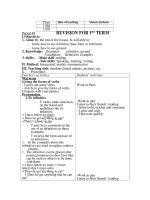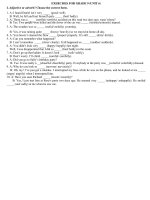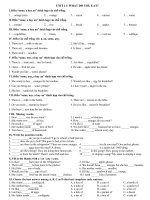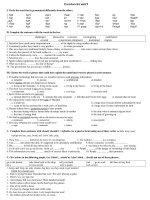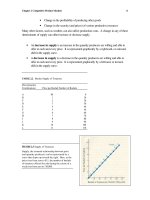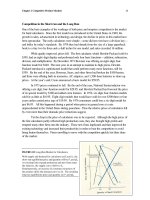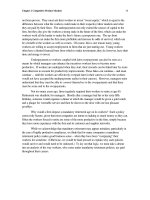Tài liệu DESIGN FOR NON-DESIGNERS pot
Bạn đang xem bản rút gọn của tài liệu. Xem và tải ngay bản đầy đủ của tài liệu tại đây (2.03 MB, 11 trang )
Composition & Layout
I. Composition
The two most important design principles which determine how
we react to visual cues on a page, computer screen, overhead cell,
etc. are:
• contrast
• organization
Common sense proves we see:
• big things before small things
(contrast of scale)
• dark things before light things on
a design field (contrast of value)
• things on top before things below
(contrast of placement)
We prefer to see design fields with a
sense of order and structure which are
visually logical (organization).
2
II. Layout
The easiest way to achieve a good layout for your design field is to
create a grid. A grid consists of a series of non printing horizontal
and vertical lines which help in the placement of typography,
graphic elements, lines, boxes, photos, etc. on a design field. The
grid makes it possible to maintain consistency from design field
to design field even though the contents of each field may change.
Another way to achieve a good layout is to create an organic
design field. This is accomplished by positioning typography
and graphic elements without a distinct alignment plan or
pattern (grid). The layout should be informally balanced and
visually pleasing. (note: the organic layout should not be used
for an entire series of design fields but can be used for one or
two within a grid system layout.)
III. Typography
A. Type Categories
1. Serif Typefaces–serifs are small finishing strokes at the
ends of main character stems of letters. Serif typefaces are
very easy to read because the serifs form a baseline for the
eye to follow.
2. Sans-serif Typefaces–typefaces comprised of letters that
do not have small finishing strokes at the ends of main
character stems. Vertical and horizontal stems are usually
the same weight. Sans–serif typefaces are usually bolder
than serif typefaces. Their simplicity and neutral style are
effective for most topics but should never be used for
large amounts of copy because the reader’s eyes often
“double–back” or have difficulty “tracking” the copy from
line to line.
3. Script Typefaces–similar to handwriting or calligraphy.
Script typefaces are too ornamental for presentation
graphics and should be used sparingly. (note: never set
copy in all capital letters using a script typeface because
it will be illegible.)
4. Display Typefaces–typefaces which really don’t fit any
of the other categories. Display type is usually ornamental
in nature and chosen for style rather than legibility and
should be used in moderation.
3
B. Type Fonts
The full alphabet, numbers, punctuation and symbols set
in one weight and style of a typeface.
ABCDEFGHIJKLMNOPQRSTUVWXYZ
abcdefghijklmnopqrstuvwxyz
1234567890
,./';[]=-!@~$%^&*()_+?.,:"}{
Palatino Bold
C. Type Families
Several fonts that are variations of one typeface design.
Palatino ABCDEFGHIJKLMNOPQRSTUVWXYZ
Palatino Bold ABCDEFGHIJKLMNOPQRSTUVWXYZ
Palatino Italic ABCDEFGHIJKLMNOPQRSTUVWXYZ
Palatino Bold Italic ABCDEFGHIJKLMNOPQRSTUVWXYZ
D. Legibility/Illegibility or NO–NOs on the Design Field
1. Never mix two similar typefaces. Instead try mixing a
serif with a sans–serif typeface. (Times with Helvetica)
2. When using a type family, limit yourself to two or three
variations. More than three results in a cluttered look.
3. Avoid using fancy Display Typefaces. They are often
difficult to read.
4. Avoid setting large blocks of type in italic or bold.
Again, they are difficult to read.
5. Avoid setting Script and Old English typefaces in
all caps. The result is illegible copy.
note: Allow enough white space around type and graphics.
The reader’s eye is attracted by white space making individual
elements easier to understand.
4
E. Type Favorites
1. ITC Avant Garde Gothic–A modern, clean, distinctive
choice which is good for material that is referenced on a line
by line basis.
2. ITC Bookman–A great typeface for display applications
with a strong, straightforward look. Also excellent for short
blocks of type requiring legibility.
3. ITC Garamond–A typeface with a classic, elegant look
which is very legible. The italic version is also very legible.
4. Optima–A highly legible sans–serif typeface which can
be used with other serif and sans–serif typefaces.
5
5. Palatino (resident font)–A good typeface for headline
and display applications. Copy set in Palatino is highly
legible. This is an excellent typeface to use for overhead cells
anD looks good when combined with Helvetica.
6. Times Roman(resident font)–Serious, straightforward
information looks good set in Times Roman. It is legible
and can be used alone or with a sans–serif typeface
for contrast.
7. Helvetica (resident font)–A good typeface that is
unobtrusively legible. Headlines set in Helvetica look
authoritative and work well with copy set in a serif typeface.
note: Avoid using Charcoal, Chicago, Courier, Geneva,
New York and Monaco which are the other resident fonts
in the Macintosh system. These are fonts created specifically
for the computer and lack the sophistication the afore-
mentioned fonts have.
6
IV. Proportions
When working on any design field, rough out your ideas
on paper making sure your sketches which are called
“thumbnails” are in proportion to the final size of your
design field. Use these thumbnails as guides when you work
on your computer, making adjustments if necessary.
L. Moholy–Nagy, Director of the Institute of
Design in Chicago and father of the Bauhaus
movement stated, “Form Follows Function.”
In other words, the composition and layout of
a design field is defined by the work it has to
do. Rely on the logical placement of black and
white and/or color type forms, design elements and graphics,
keeping visual balance and tension as your goal.
7
V. The Use of Color in Presentations
A. Portray Concepts & Ideas
• Natural Things–greens, blues, browns
• Warnings & Danger–yellows and reds
• Abstract Ideas & Symbols–any color could be used to
create a symbolic association.
B. Coding
• Association–by using a consistent color scheme
• Differentiation–by using different colors for
different elements
• Hierarchies–by using color schemes with increasing
value/saturation levels, light–to–dark or gray–to–bright
sequences indicate importance levels
• Emphasis–highlighting specific words or phrases
in different colors
8
C. Color Cautions
• If it doesn’t work in black & white, it won’t work in color.
• Don’t overuse color. Two or three colors on a graphic
field is sufficient.
• Dark green or dark blue type on a black background
should be avoided but both colors work well on a
white field.
• Yellow type on a white field is impossible to read but
works fine on a black background.
• Red type works fine on white or black backgrounds.
D. Color Systems
1. RGB–computer colors seen on the screen are produced
by mixing Red (R), Green (G) and Blue (B) beams of light.
RGB is an additive process.
2. CYMK–pigments, inks, dyes and toners are applied to
a surface to create colors. Pure Cyan (C), Yellow (Y),
Magenta (M) and Black (K) mixed together would produce
black. By subtracting some values of C, Y, M and K millions
of other colors can be produced therefore CYMK is a
subtractive process.
3. RGB to CYMK Conversion–RGB colors (computer) are
converted to CYMK when printed on a color printer.
The translation from RGB (additive) to CYMK (subtractive)
is a difficult task and many times what-you-see on the
computer is different from what-you-get on a color printer.
You can choose color palettes that are flexible so that color
variations are not important or you can check the soft-
ware you are using to make corrective color adjustments.
9
VI. Static/Moving Images
A. Static Images–can be very effective if they are used to
support written material. The addition of color to a static
image can further enhance its effectiveness.
B. Moving Images–are more difficult to assess as to their
effectiveness because of their relative “newness” in
presentations. Animated objects and icons as well as
Quicktime™ movies, etc. are evident on the Internet,
Home pages, educational games, software applications
and product demos. In many cases I think “moving
images” are overused. They’re “cute” and entertaining
but do they teach?
Consider the following criteria when contemplating the use
of moving images:
• Production–is the necessary software and expertise available
to help you incorporate moving images in your presentation?
• Space–is their enough storage capacity on the particular
media you are using to include moving images? (animation
is a real memory hog)
• Questions–?????
Are moving images better than words?
Can you set up Action/Consequence Scenarios?
Do you have a metamorphosis sequence
(larva to butterfly)?
Have you tried other strategies but moving images
seems right?
10

